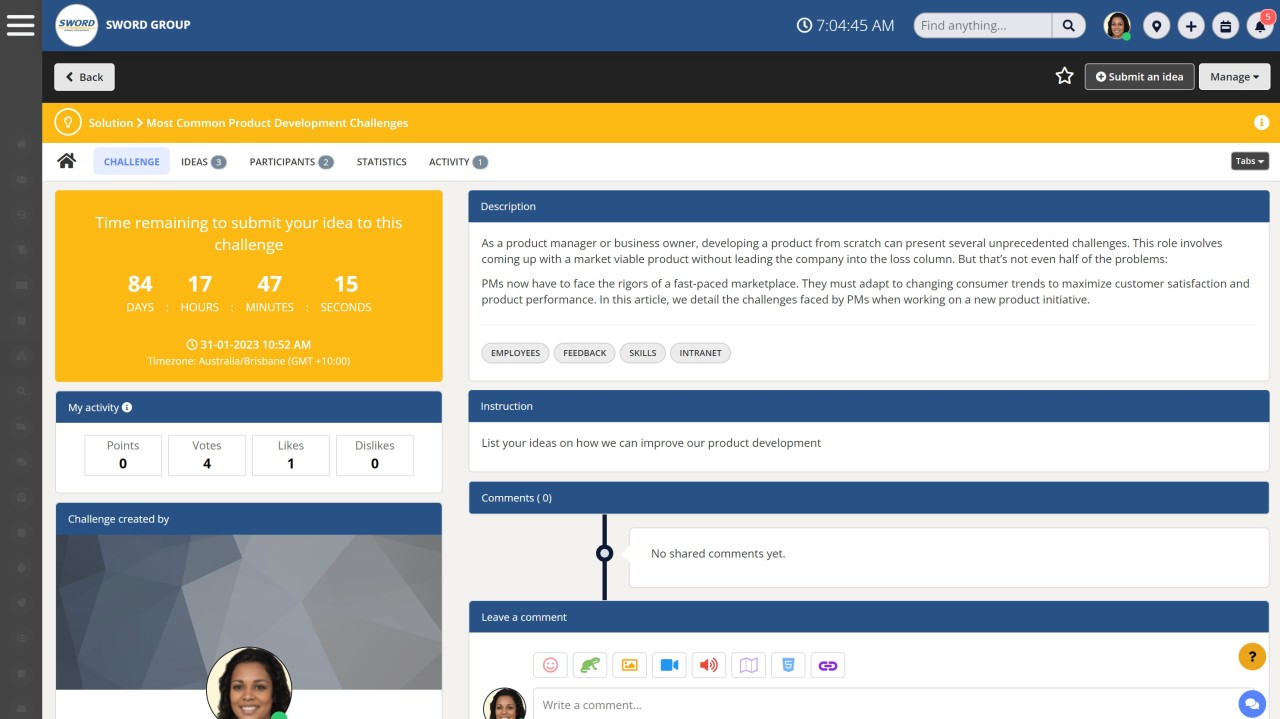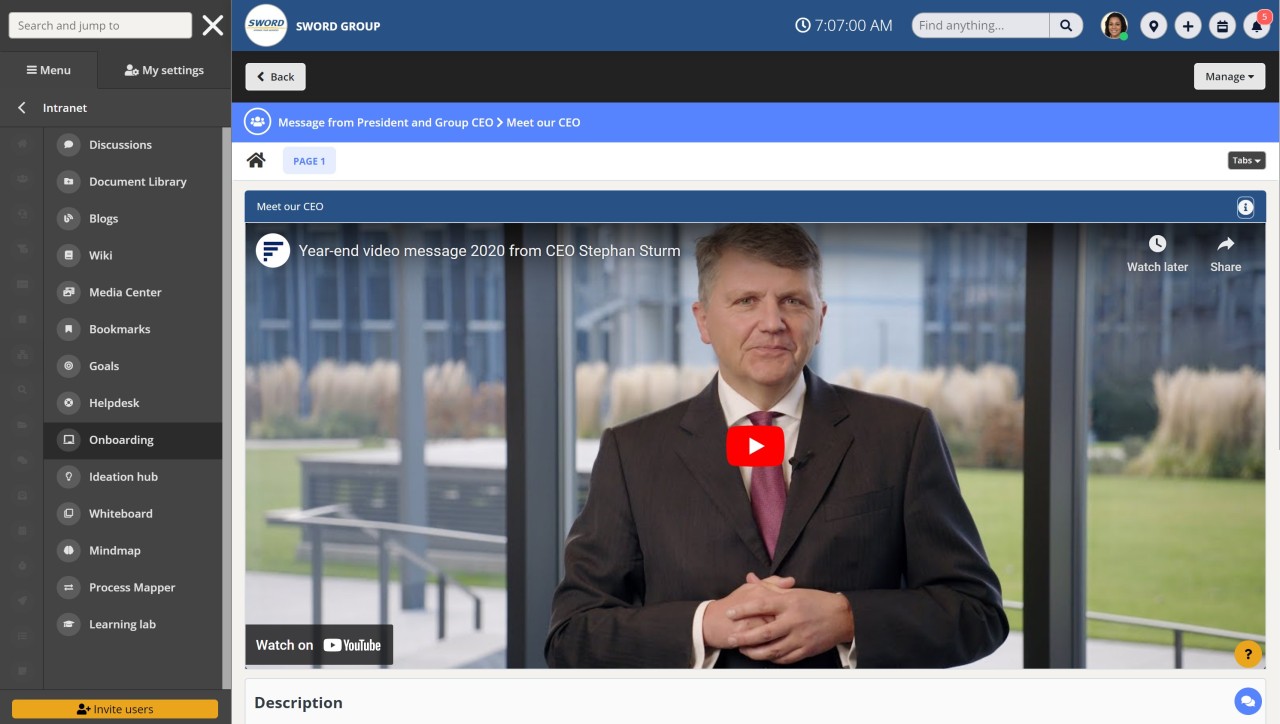Insight Blog
Agility’s perspectives on transforming the employee's experience throughout remote transformation using connected enterprise tools.
13 minutes reading time
(2593 words)
Digital employee onboarding in 2022: Process, trends, and benefits
Employers can save time and money by switching to a digital onboarding process, all while providing a more flexible, individualized experience for new hires.
New hires need proper onboarding to feel at ease in their new positions and quickly contribute to the company's success. New hires need to be welcomed into the firm, introduced to their new team and made aware of the organization's overall mission and objectives through a well-executed employee onboarding process. Employee onboarding prepares new hires for future success if done properly.
New apps and technologies are being adopted by businesses in order to modernize their employee onboarding procedures and provide new levels of interactivity and convenience.
Employers can save time and money by switching to a digital onboarding process, all while providing a more flexible, individualized experience for new hires.
What is digital onboarding, and how it works?
The process of bringing a new employee on board is usually complicated. The new employee must be familiarised with the norms and practices of your company. There is also the matter of complying with regulations and paying the appropriate taxes. Recently, technology has helped HR departments streamline the onboarding process by providing digital tools.
By giving centralized access to all information around the clock, digital onboarding allows firms to establish a cost-effective, efficient employee onboarding checklist by personalizing the onboarding process and helping new hires become familiar with the company's workflows.
Digital employee onboarding: Process, trends, and benefits
A well-designed onboarding program can help get new employees off to a great start, boost morale, and boost the company's bottom line. However, it can be difficult to provide rapid access to resources for hundreds of newly hired staff.
The digital employee onboarding process
The process of bringing a new employee on board is usually complicated. The new employee must be familiarised with the norms and practices of your company. There is also the matter of complying with regulations and paying the appropriate taxes. Recently, technology has helped HR departments streamline the onboarding process by providing digital tools.
With the use of digital tools, the process of welcoming new employees may be streamlined, productivity can be increased, and costs can be cut.
Training programs for new workers might take a significant amount of time (hours, days). Both employees and employers will appreciate a reduction in the amount of time spent on this.
The 4Cs of Onboarding, or what needs to be in place for successful onboarding, are compliance, clarification, culture, and connection. Taking care of these four areas of onboarding can be difficult in today's hybrid and remote work styles.
Compliance
This includes studying the organization's ground rules and completing the necessary papers. This step of the onboarding process is made easier by technological advancements. By signing electronic documents, for instance, workers can attest that they've seen all required training videos and presentation materials.
Clarification
In this phase, new employees are briefed on their roles and the specifics of any upcoming initiatives or duties. Video conferences and webinars can also help make things easier for distant workers in this regard.
Culture
Management and human resources typically establish the company's culture and explain how things work. While this is more difficult to explain digitally, pairing a new hire with an experienced employee can assist them in adjusting to the company's norms and values.
Connection
This is likely the most challenging feature to provide in a digital format. Relationship building is facilitated in the traditional onboarding model because the employee is present in the office. It may be challenging in a digital world and may require some innovative thinking to inspire employees to form work relationships. Tools like group chats and file sharing can be useful.
Digital onboarding trends 2022
There has been a rise in the use of freelancers and other forms of remote labor in recent years. When a company is used to the time-consuming process of traditional onboarding, onboarding thousands of remote workers might be a challenge.
Workers in remote locations frequently utilize a wide range of unmanaged devices, such as personal computers, printers, and other devices that can be found on the company's internal network. IT departments must be versatile in order to support a wide variety of company-issued mobile devices. This condition typically causes a wide range of problems for employees attempting to use the systems of the new company, leading to an increase in the number of IT ticket requests.
Possible employee onboarding trends can be:
- Use of Virtual Reality in the onboarding process
- Increased use of machine learning in employee onboarding
- Reshaping the onboarding process with AI
- Interactive onboarding process
- More inclusive onboarding programs
- Evolution of remote or hybrid onboarding process
Why is digital employee onboarding important, and what are its benefits?
Just a handful of the ways in which digital onboarding excels over its in-person predecessor are listed below.
It is an ongoing process
To be effective; onboarding must be viewed as an ongoing process. This may call for a radical shift of perspective on the part of some businesses. The way they think about onboarding will need to shift. Onboarding isn't a one-and-done thing; rather, it's the first step in what will be an ongoing procedure. There will never be a pause in progress if you commit to a learning strategy of continuous improvement.
Employees' skill sets, productivity, and satisfaction all increase on a consistent basis because of the individualized and flexible nature of their training. The secret sauce is a micro-learning platform that uses learning reinforcement to do this. We now have the tools to facilitate such advanced learning. The mindset of the modern worker toward lifelong learning has been essential in making this possible.
Increase in interactions and social networking
Connecting with others and feeling like you belong are two things that cannot be undervalued. As part of the onboarding process, new hires should be introduced to important stakeholders in the company. Creating a sense of community through digital social channels like Whatsapp groups, Slack, and Skype is quite beneficial.
An online 'green room' is being implemented by some businesses to let new employees meet each other, network, and provide mutual support. It's worth noting that some forward-thinking businesses have actually polled their employees on how they would like the onboarding process to go.
Sticking to ethics and company messages
When it comes to new hire orientation, consistency has always been the enemy. New hires receive consistent training, and the company's culture and values are ingrained throughout the organization with the help of digital onboarding. A simple online "welcome" video from the CEO could do the trick.
In the Specsavers preboarding program, for example, a mandatory online 'values' induction training for all new joiners is done in a lighthearted manner with quizzes and gamification. It's not enough to be consistent; you also need to motivate new workers with high-quality engagement.
It is more efficient
The onboarding process can be tailored to the new employee's schedule and completed considerably more quickly when done digitally. Managers are spared the time and effort of sifting through piles of paperwork if they have instant access to all onboarding data. Additionally, online onboarding can start even before the new hire arrives at the office. The procedure is sped up, and some resources are saved as a result.
Accessibility
The new hire's onboarding process can be accessed at any time, even after they have started working for the organization. This means that even if you misplace or forget certain information, you can readily get it from the internet.
Cost-effective
Because digital onboarding reduces the need for one-on-one training, it can help you save money. Training employees or HR directors is one method of doing this.
Digital workplace and employee experience
While you may be familiar with the concept of employee experience in general, you may be unfamiliar with the term "digital employee experience" or how it relates to the happiness of a company's workers.
The effect of a company's technological services on its employees is known as the "digital employee experience." There's a good probability that your digital employee experience isn't ideal if, for instance, your company expects workers to use more than 10 different digital products, none of which are easy to use and all of which require considerable onboarding. This is not an outlandish scenario, especially considering that 78% of employees report using 6-10 different digital platforms for workplace communication alone.
The digital employee experience is likely to be good if workers have a favorable impression of the tools they need to do their jobs, encounter few problems with the technology they use on a regular basis, and believe that the technology available to them enhances their time at work.
Why does employee experience matter in the digital workplace?
Digital employee experience is an integral aspect of the digital workplace and can have a profound effect on employee satisfaction and pleasure. More than 75% of the workforce will be comprised of "digital natives" by 2025, and these individuals have grown up with technology and have high expectations for its reliability.
Technology issues at the job can be just as frustrating as having your home WiFi frequently cut out while playing a game on your laptop. When it's something you have to deal with on a regular basis, you're more likely to feel bitter toward your employer over time.
The basic premise is that contented workers are those who have access to the resources (including IT help) needed to complete their jobs efficiently. Human resources and information technology departments gain an advantage in the job market and cultivate an engaged staff when they collaborate to improve the digital employee experience.
Benefits of a digital workplace
Improvement in employee satisfaction
Peer networking, team connections, and idea exchange can all flourish in a well-designed digital workplace. Employees are more content and invested in their work when they have these options, which give them a voice and make them feel valued.
Furthermore, workers who occasionally work from the home report being 24% happier on the job. The widespread availability of remote work opportunities made possible by the digital workplace increases the adaptability and responsiveness of your staff to employee needs.
Better talent retention and recruitment
Talented individuals have become accustomed to the idea that their work must be very contemporary and cutting-edge even to be considered. If you provide those needs through a digital platform, you'll be able to entice talented, creative people to apply.
Enhanced efficiency
You can measure key performance indicators (KPIs) like the percentage of visitors that bounce and the amount of time they spend on your site with the help of efficient digital solutions, such as an intranet that can make use of Google Analytics integration. You'll be able to identify internal and external optimization opportunities with this data.
Revenue generation
When a company can simultaneously cut expenses and boost output, it enjoys the dual benefit of a larger profit margin. Indeed, businesses have seen a 43% increase in revenue after adopting digital workplaces.
Productivity and efficiency enhancement
Now more than ever, thanks to tools like Google Docs and group calendars, people can work together in real-time to get things done without waiting. These technological developments simplify procedures and permit workers to accomplish more in less time. A recent poll by cloud service provider CoSo Cloud found that 77 percent of remote workers reported increased productivity. The advent of time-saving technology innovations has undoubtedly contributed to this trend.
Digital employee onboarding challenges
Maybe you've already filled a position with the help of web recruitment. Employees can now start being onboarded digitally. However, potential employers may be wary because of how impersonal it seems. This is due to the fact that digital onboarding may be conducted from afar, unlike the in-person process of traditional onboarding.
An organization may worry that its new hire is first too distant from the operation. Because of this, students might not get the necessary introduction to fundamental capabilities. In addition, it may hinder their ability to understand the organization's culture. As a result, businesses are concerned that this will discourage new hires and increase the turnover rate.
Providing the organization has designed a good onboarding process, it can be as successful as a more conventional one. The key to doing this is for the organization to provide a tailored onboarding experience. When you do this, you can rest assured that it won't be replicated anywhere else. Plus, new hires won't feel like they're missing out on anything.
How to improve the digital employee onboarding experience?
Prospective employees can get a feel for the company's values and mission through online recruitment. But how can a business tailor its digital onboarding to mirror such an encounter? With the help of some fresh ideas and fascinating methods!
Use digital onboarding solutions
The recruitment process is being completely transformed by online web recruitment. New hire orientation is quickly transitioning to the digital realm. In order to ease the transition for new employees, firms must tailor their onboarding processes to their specific needs. An employee's first impression of the company and the relationships they build there can be profoundly impacted by the onboarding process. In the end, if everything goes as planned, everyone benefits.
Starting the onboarding process early
Integrating new hires into the team quickly is a crucial part of keeping them. Candidate signatures on offer letters are a common indicator that they may back out shortly before the first day of work. The onboarding process must start as soon as they sign the contract. This starts the ball rolling for development and integration.
Improve communication
It is impossible to establish teams and get beyond communication roadblocks without first making good first impressions. Use lighthearted quizzes, surveys, and icebreaker games to get your staff talking to one another. New hires might benefit greatly from problem-solving activities as part of the orientation process.
Provide digital training
In a nutshell; onboarding is the process of providing new employees with the resources they'll need to do their jobs well. Therefore, growth and improvement ought to be fundamental to the procedure. Learning modules are a great method to prepare new hires for success. Prerecorded movies on business principles and ethics and one-on-one discussions with HR specialists are also helpful.
Conclusion
New employees will increasingly be acclimated to their new workplaces through digital employee onboarding. If an organization wants to successfully onboard new employees, it must tailor its onboarding process to each individual. You can use digital employee onboarding solutions like AgilityPortal. The onboarding process can profoundly impact an employee's first impression of the company and the relationships they build there. In the end, if everything goes as planned, everyone benefits.
Categories
Blog
(2594)
Business Management
(318)
Employee Engagement
(206)
Digital Transformation
(172)
Intranets
(119)
Growth
(118)
Remote Work
(61)
Sales
(48)
Collaboration
(37)
Culture
(29)
Project management
(29)
Customer Experience
(26)
Knowledge Management
(21)
Leadership
(20)
Comparisons
(5)
Ready to learn more? 👍
One platform to optimize, manage and track all of your teams. Your new digital workplace is a click away. 🚀
Free for 14 days, no credit card required.




















